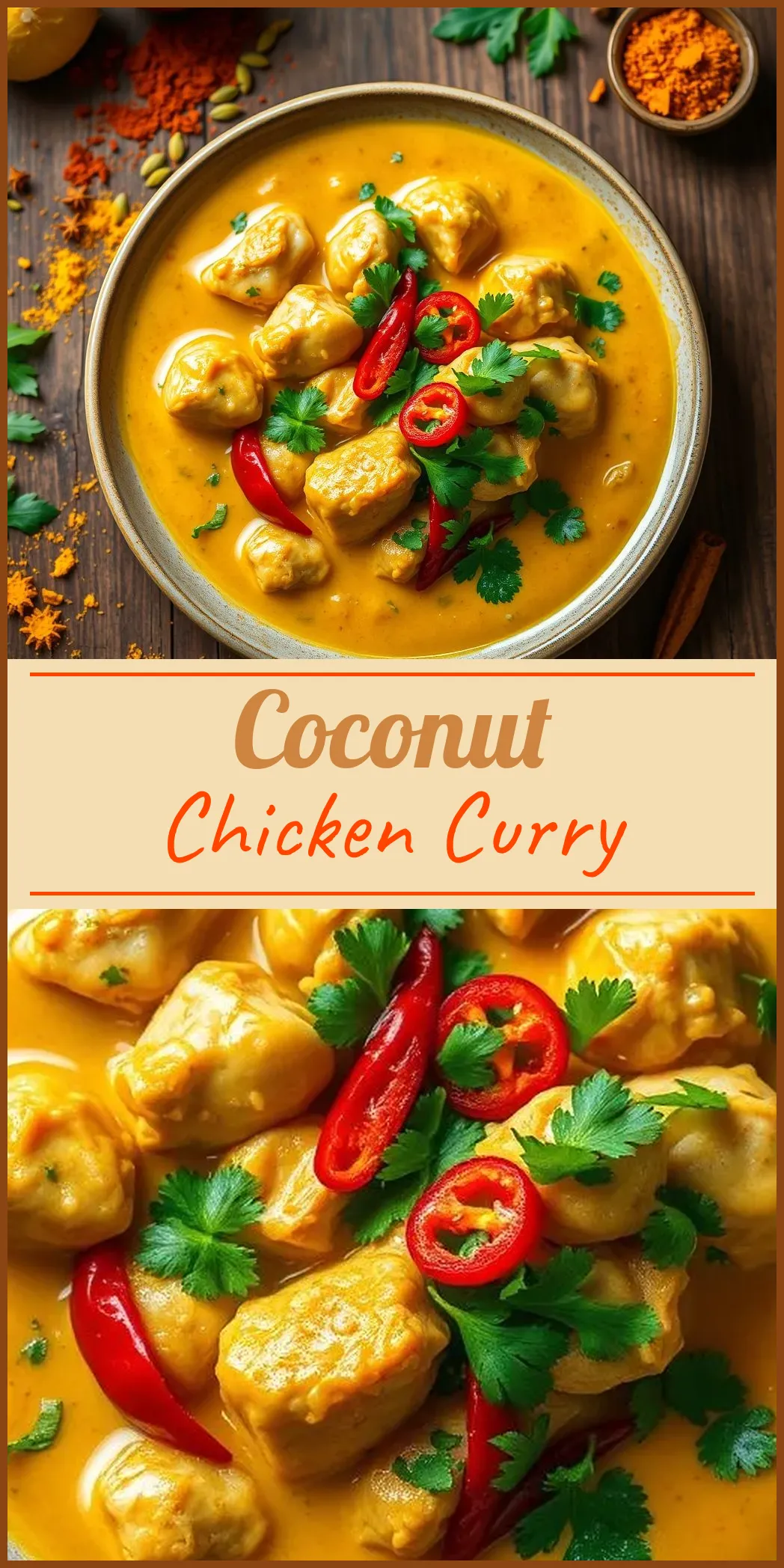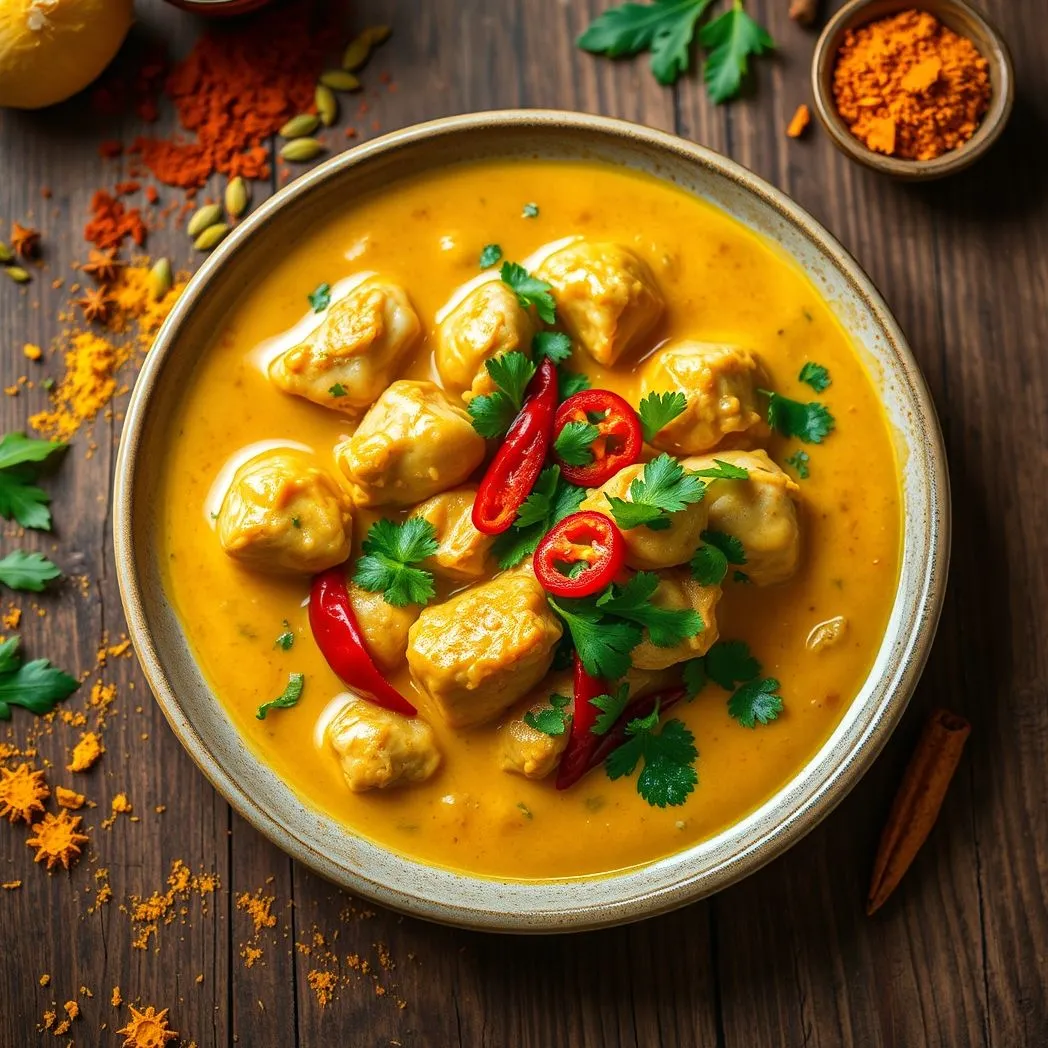Coconut Chicken Curry is a warm and inviting dish that brings a blend of vibrant spices and hearty ingredients into one comforting bowl. In this article, we will explore every detail of this classic recipe, ensuring you are fully equipped to cook a fulfilling, flavorful meal. Whether you are a beginner or an experienced cook, this guide will provide clear steps, tips, and variations to suit your taste.
Introduction
Coconut Chicken Curry is more than just a meal; it is an experience. Its roots lie deeply in South Asian culinary traditions, where fresh spices and creamy coconut milk are celebrated for their ability to create a rich, exotic flavor. The dish combines tender chicken with a luscious sauce that is both aromatic and satisfying. The beauty of this curry lies in its versatility and simplicity—ideal for a busy weeknight dinner or a special gathering with family.
Key Flavors and Techniques
Throughout this guide, you will learn the art of balancing spicy warmth with coconut creaminess. You will discover how to:
– Bloom spices for a robust flavor foundation.
– Sear chicken to lock in juices and flavor.
– Simmer gently to allow all ingredients to meld perfectly.

These techniques ensure that every bite bursts with a delightful harmony of flavors, making this dish a true culinary standout.
Ingredients
Creating the perfect Coconut Chicken Curry begins with assembling high-quality ingredients. Choosing the right ingredients makes all the difference in taste and texture. Here is what you need:
Main Ingredients
- Chicken: Use boneless, skinless chicken thighs for a tender and juicy finish. Alternatively, boneless chicken breasts work well if you prefer leaner meat.
- Coconut Milk: Full-fat coconut milk is recommended to achieve a creamy texture and rich flavor.
- Chicken Broth: Use low-sodium broth to enhance the taste while keeping the seasoning balanced.
Aromatics and Spices
- Onion, Garlic, and Ginger: The trio forms the flavor base. Use finely chopped onions, minced garlic, and grated ginger.
- Spices: Incorporate curry powder, ground turmeric, ground coriander, and a pinch of cayenne pepper for heat. Fresh curry paste or tomato paste can also be added for added depth.
- Brown Sugar: A touch of brown sugar balances the spices and enhances the sauce’s sweetness.
- Lime Juice: Freshly squeezed lime juice brightens up the curry and provides a subtle tang.
- Fresh Herbs: Cilantro leaves are ideal for garnish, adding a pop of color and fresh flavor.
Cooking Essentials
- Coconut Oil: Use this oil for sautéing vegetables and blooming spices. It reinforces the coconut flavor throughout the dish.
- Salt and Pepper: Season as needed to elevate all the flavors in the curry.
Equipment and Preparation
Having the proper equipment on hand is essential for a smooth cooking process. Here are some basic tools you will need:
Essential Tools
- Large, Deep Skillet or Dutch Oven: For sautéing the aromatics and simmering the chicken.
- Cutting Board and Knife: To chop your vegetables and herbs accurately.
- Measuring Cups and Spoons: To ensure precise measurements of spices and liquids.
- Wooden Spoon or Spatula: For stirring and monitoring the dish as it cooks.
Before you start cooking, prepare your ingredients by:
– Chopping the onions, garlic, and ginger.
– Measuring out coconut milk, chicken broth, and spices.
– Cutting chicken into bite-sized pieces.
– Juicing the lime and preparing fresh cilantro for garnish.
Step-by-Step Cooking Process
Follow these clear, step-by-step instructions to bring your Coconut Chicken Curry to life:
1. Sauté Aromatics
Begin by heating coconut oil in a large, deep skillet or Dutch oven over medium-high heat. Once the oil shimmers, add the chopped onions. Sauté until they become soft and translucent, about 3-4 minutes. This step creates the flavor base essential for the curry.
2. Bloom Spices
Introduce garlic and ginger to the skillet. Stir them into the softened onions. Then, add your chosen spices—curry powder, turmeric, coriander, and cayenne pepper. Bloom these spices, stirring continuously for 1-2 minutes until they release a fragrant aroma. Blooming spices in oil unlocks their full potential.
3. Brown the Chicken
Add the chicken pieces to the skillet. Arrange them in a single layer, letting them brown without being crowded. Turn the chicken to ensure even browning. The browning process seals in the juices and adds a subtle depth to the curry.
4. Incorporate Liquids
Pour in the coconut milk and chicken broth. Stir to combine the browned chicken with the aromatic base. Add a spoonful of tomato paste if you desire a richer color and a deeper flavor. Incorporate brown sugar and lime juice, which help balance the spices. Bring the mixture to a gentle simmer.
5. Simmer the Curry
Reduce the heat to low and let the curry simmer uncovered for 20-25 minutes. This slow simmer allows the flavors to meld beautifully. Stir occasionally to prevent sticking. Check that the chicken is fully cooked and tender. Season with salt and pepper to taste during the last few minutes of simmering.
6. Finishing Touches
Once the curry has thickened slightly and the flavors have melded, remove the skillet from heat. Add freshly chopped cilantro as a final garnish. This adds a burst of freshness that contrasts the warmth of the spices.
Tips for Making the Best Coconut Chicken Curry
Small adjustments can make a significant difference in your final dish. Consider these practical tips to perfect your curry:
- Lean on Fresh Ingredients: Fresh garlic, ginger, and onions provide a foundation for a vibrant flavor profile.
- Simmer Gently: Avoid high heat once the liquids are added. A gentle simmer preserves the silky consistency of the coconut milk.
- Customize Your Spice Level: Start with a moderate amount of cayenne pepper or chili powder. Adjust gradually to suit your preference.
- Experiment with Variations: Enhance the dish by incorporating vegetables such as bell peppers, carrots, or potatoes. These add texture and nutritional variety.
- Use Bone-In Chicken: For a more robust flavor, use chicken thighs with the bone in and simmer a few extra minutes.
- Balance Flavors: Monitor your seasoning. The sweetness of brown sugar and the acidity of lime juice should work together without overpowering the dish.
Serving Suggestions
Coconut Chicken Curry is versatile and pairs wonderfully with several side dishes. Here are some delightful serving ideas:
Best Pairings
- Steamed Rice: Basmati or jasmine rice makes an excellent base for soaking up the delicious sauce.
- Naan or Flatbread: Soft, warm naan is perfect for dipping into the curry.
- Cauliflower Rice: For a low-carb option, serve with cauliflower rice. It is light, flavorful, and offers a nice texture contrast.
- Fresh Salad: A crisp salad decorated with citrus dressing can provide a refreshing accompaniment to the rich curry.
Presentation
Plate the curry garnished with extra cilantro and a wedge of lime. A pop of color and a squeeze of fresh lime enhance the visual appeal and taste of the dish. Use a shallow bowl to highlight the layered complexity of the sauce.
Variations and Adaptations
Cooking is a creative endeavor, and this recipe welcomes variations. Use these ideas as inspiration to tailor the curry to your taste:
Different Proteins
- Shrimp or Tofu: Replace chicken with shrimp or tofu for a delightful change. Adjust the cooking time to suit the protein.
- Mixed Proteins: Combine chicken with another protein for a unique twist.
Vegetable Additions
- Bell Peppers and Carrots: Add colorful bell peppers and sliced carrots during the simmering phase.
- Leafy Greens: Stir in spinach or kale a few minutes before removing from heat to infuse the dish with additional nutrients.
Spice Adjustments
- Milder Curry: Reduce the amount of cayenne pepper for a milder flavor profile.
- Extra Heat: Increase the spices or add a dash of hot sauce for those who prefer a spicier kick.
Storage and Reheating
Coconut Chicken Curry is not only delicious when freshly made but also tastes even better the next day. Learn the best practices for storing and reheating leftovers:
How to Store
- Refrigeration: Allow the curry to cool slightly. Transfer it to an airtight container and refrigerate. Consume within 3-4 days for optimal freshness.
- Freezing: Divide the curry into freezer-safe containers. Freeze for up to 3 months. Thaw overnight in the refrigerator before gently reheating.
Reheating Method
- Stovetop: Warm the curry in a saucepan over medium-low heat. Stir occasionally until heated through.
- Microwave: Use 30-second intervals, stirring between cycles, until the dish is hot.
Proper storage not only preserves the flavors but also ensures that the texture remains consistent when enjoyed again.
Serving for Special Occasions
While Coconut Chicken Curry is perfect for casual dinners, it can also be elevated for special occasions. Consider these ideas to impress your guests:
Festive Presentation
- Elegant Plating: Use a shallow, wide bowl to display the vibrant colors of the curry. Garnish with additional cilantro and a drizzle of coconut milk.
- Accompaniments: Serve alongside a platter of naan, a fresh salad, and a cooling raita. This combination provides a balanced and harmonious meal.
Entertaining Tips
- Prepare the curry ahead of time. This allows more time for entertaining guests.
- Arrange the sides in decorative bowls to enhance the overall presentation.
- Suggest a themed dinner night where the flavor profile of the curry is celebrated with complementary drinks and desserts.
Crafting a perfect Coconut Chicken Curry at home is a journey into flavor. The blend of warm spices, tangy lime, and creamy coconut milk creates a dish that is at once comforting and exotic. Personalizing the recipe with your choice of proteins, vegetables, and spices allows you to make it uniquely yours. With clear instructions and practical tips, you can create a meal that is not only delicious but visually stunning.
Enjoy the process of cooking and share this dish with family and friends. Each step of the process—from blooming spices to simmering the curry—adds depth and character to your meal. Let the aroma fill your kitchen, and savor each mouthful of this ultimate comfort food.
Remember, the heart of this recipe is its simplicity and adaptability. With practice, your Coconut Chicken Curry will evolve into your signature dish that evokes warmth and satisfaction. Enjoy every step and every bite as you explore the rich tapestry of flavors that this dish offers.
Happy cooking and bon appétit!

Coconut Chicken Curry
This aromatic coconut chicken curry has the perfect balance of spices and creaminess. It is ready in a flash. It is super rich and creamy. It is insanely good.
Ingredients
- 4 garlic cloves, minced
- 2 teaspoons brown sugar
- salt and pepper, to taste
- 1 teaspoon ground turmeric
- 2 tablespoons coconut oil
- juice of 1 lime
- 2-3 tablespoons red curry paste
- 2 tablespoons butter
- 1 teaspoon ground coriander
- 2 pounds boneless, skinless chicken thighs, cut into 1-inch pieces
- 2 teaspoons curry powder
- 1 large onion, finely chopped
- 1/2 teaspoon cayenne pepper (adjust to taste)
- 1/2 cup chicken broth
- 1 tablespoon grated fresh ginger
- 1 (14 ounce) can full-fat coconut milk
- 1 tablespoon tomato paste
- fresh cilantro leaves, for garnish
Instructions
- Warm the coconut oil in a large, deep skillet. Use medium-high heat. Add the onion. Cook until soft, about 5 minutes.
- Add the garlic, curry paste, tomato paste, ginger, curry powder, turmeric, coriander, and cayenne pepper. Cook for 1-2 minutes, stirring frequently. Continue cooking until fragrant.
- Add the butter and chicken pieces. Stir to coat the chicken with the spices. Cook for 5 minutes, stirring occasionally. The chicken should be browned.
- Stir in the coconut milk, chicken broth, brown sugar, and lime juice. Mix to combine. Bring to a simmer. Then, reduce the heat to medium-low.
- Simmer uncovered for 20-25 minutes. Stir occasionally during cooking. Ensure the chicken is cooked through and the sauce has thickened slightly. Taste and season with salt and pepper, as needed.
- Serve hot with steamed rice or naan bread. Garnish with cilantro leaves. Enjoy!

